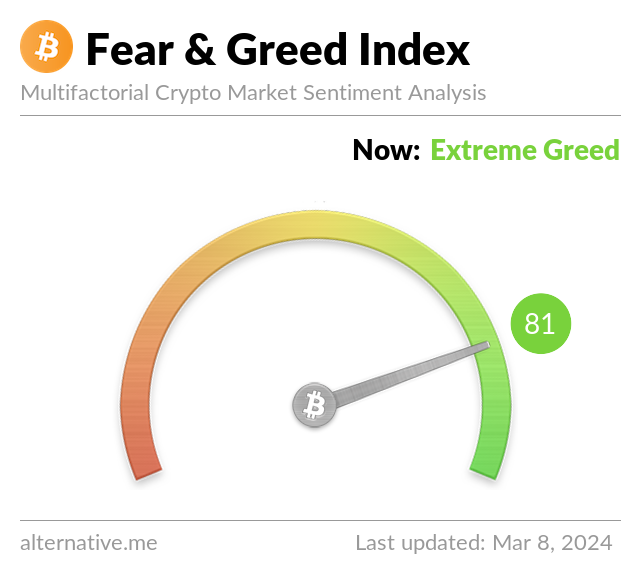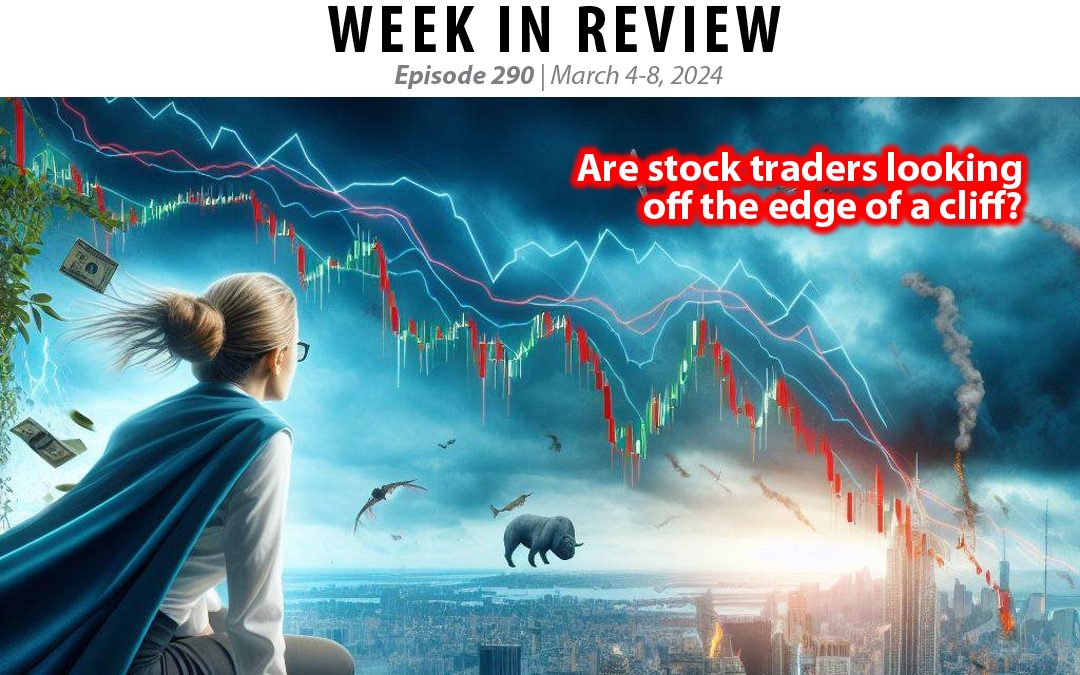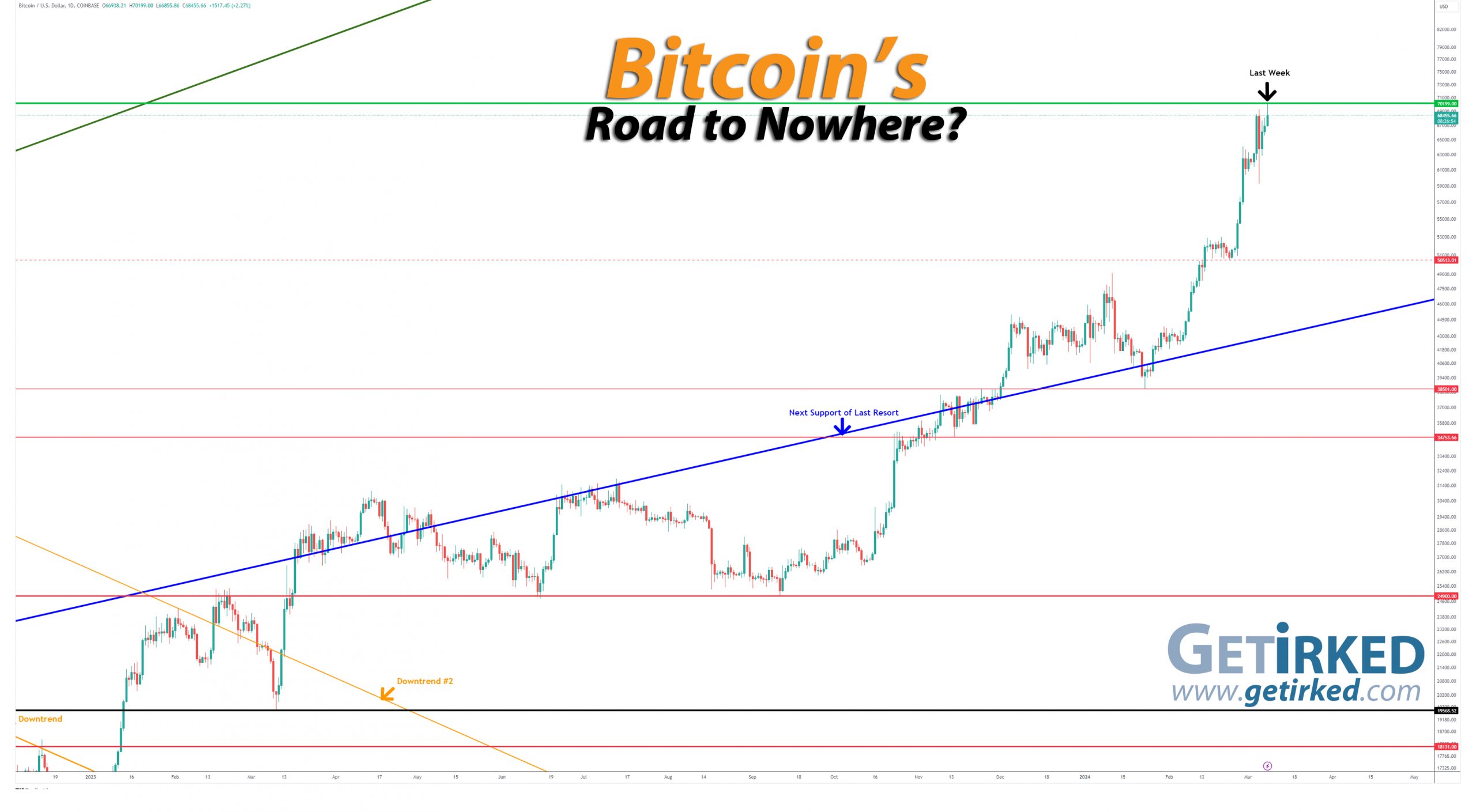Summing Up The Week
The rallying call throughout stocks, Bitcoin, and even gold seems to be “BUY THE DIP!” The Bulls are in full control of markets, and even when we have a slightly exciting day like Tuesday where the S&P 500 pulled back more than 1%, the buyers come back in force and buy stocks back up the next day.
Investing theses are also holding strong – artificial intelligence, specifically. With the rest of the market finishing down on Tuesday, Nvidia (NVDA) actually finished up. Bulls believe this is a good sign because Nvidia is basically a “flight-to-safety” growth asset. Bears are concerned that Nvidia will soon exhaust all potential buyers. Only time will tell.
Let’s look at the news that moved the markets this week…
Market News
OPEC+ producers extend cuts until end of June
Over the weekend, Saudi Arabia, Russia, and other OPEC+ producers agreed to voluntary crude supply cuts until the end of June, reported CNBC. The price of WTI oil had already broken $80 briefly last week, so the news of even longer cuts is not good news for those preferring to keep oil prices down.
While the rising price of oil – and gasoline – directly affects inflation, it does not affect the measurements that the Federal Reserve prefers to review. Given the volatility of oil prices, the Fed choose to look at core PCE rather than taking into account the price of energy… or even shelter, in many cases.
Powell reinforces no rate cuts to Congress
When Federal Reserve Chairman Jerome Powell testified before Congress on Wednesday and Thursday, he once again reiterated that the Fed has no intention to start cutting interest rates anytime soon, reported CNBC.
“In considering any adjustments to the target range for the policy rate, we will carefully assess the incoming data, the evolving outlook, and the balance of risks,” he said. “The Committee does not expect that it will be appropriate to reduce the target range until it has gained greater confidence that inflation is moving sustainably toward 2 percent.”
However, Powell also went on to say that additional rate hikes would be extremely unlikely as the committee believes the current rate is the peak. “We believe that our policy rate is likely at its peak for this tightening cycle. If the economy evolves broadly as expected, it will likely be appropriate to begin dialing back policy restraint at some point this year,” Powell said in the comments. “But the economic outlook is uncertain, and ongoing progress toward our 2 percent inflation objective is not assured.”
As a result of no new information being presented, the stock market continued to rally despite Powell’s promises of no cuts in the near future.
U.S. added 275K jobs but unemployment rose to 3.9%
In a strange dichotomy that seems almost impossible, Friday’s nonfarm payrolls report showed the U.S. added 275,00 jobs in February versus 198,000 expected, but also that unemployment rose to 3.9% versus the expectation for 3.7%, reported CNBC.
How could an economy that’s adding jobs also see an increase in unemployment?
Even the professional pundits were thrown a bit askew by these conficting data. “It’s got literally a data point for every view on [The Fed’s] spectrum,” Liz Ann Sonders, chief investment strategist at Charles Schwab, said of the report. Those views range from “the economy is plunging into a recession to Goldilocks, everything is fine, nothing to see here. It’s certainly mixed,” she added.
Others were more or less throwing their hands up at the report. “There’s no new thing under the sun between this report and last month’s report. It doesn’t really give us a whole lot of information, other than we can qualitatively say, we’re still growing jobs at a good pace and wages are still a little bit higher than we would like,” said Dan North, senior economist at Allianz Trade Americas.
Regardless, the stock market decided to continue its rally from early in the week, adding gains on top of gains.
Next Week’s Gameplan
While there are a variety of potentially market-moving catalysts on the calendar next week, all eyes will be on Tuesday – the Consumer Price Index (CPI) for February. January’s CPI showed a surprise uptick in inflation, and Bulls are hoping that it was a one-off event.
Bears, however, expect to see another surprise increase in inflation, indicating that inflation is stickier than many expected. If the Bears are right, the release of the CPI could be the catalyst to the downside that would bring seasonality to the markets as March is typically a bad time for stocks.
Personally, I am hoping for a pullback and consolidation. Pullbacks are healthy during bull markets – they provide time for the market to digest moves and reinforce levels of support, and we’re currently nearing a record number of days between 2% pullbacks so history says we’re due.
As always, have your buying plans prepared in advance so you can pounce on opportunities should they present themselves.
I’ll see you back here next Friday, friends!
This Week in Play
Stay tuned for this week’s episodes of my two portfolios Investments in Play and Speculation in Play coming online later this weekend!
Crytpo Corner

Bitcoin Price (in USD)
%
Weekly Change
Bitcoin Price Action
Bitcoin Volatility… MAGNIFIED!
Bitcoin continued rallying this week to make a new all-time high at $69,324.58 on Tuesday, and it seems someone rang a bell because the world’s largest crypto rolled over and promptly sold off more than -14% in less than five hours!
Many pundits felt that the introduction of the Bitcoin ETFs would reduce the volatility in the space. Obviously, they were VERY wrong. All-time highs are a mixed bag in nearly every asset class, but particularly in Bitcoin. Sometimes, new highs are followed by incredible bull momentum even higher, but, sometimes, like Tuesday, they are absolutely not.
Bitcoin was able to eke out another all-time high on Friday at $70,199.00 before the Bears returned as they had earlier in the week to drive the price back down.
The Bullish Case
Bulls argue that Bitcoin’s consolidation is nothing to fret about with many giving much higher price targets. Some believe we’ll see $76K as a new all-time high in a matter of days while others are even more aggressive, believing Bitcoin will break six figures before we make it to the summer!
The Bearish Case
Bears point out that, while Bitcoin technically made a new all-time high, the lack of momentum has created a dreaded “Double Top” formation. Many analysts believe that a Double Top, when an asset hits relatively the same high and finds significant resistance, indicates that Bitcoin will pull back significantly. Even JP Morgan CEO Jamie Dimon got in on the bearish fun, claiming that Bitcoin will pull back to $42,000 in short order following the halving in April.
Bitcoin Trade Update
TRADE RESET! +10.33% Gain in 1 Week, +537% Annualized
Bitcoin pulled back to hit 2 of my buy orders last weekend giving me an average buying price of $61,233.24 (after fees). The buys lowered my per-coin cost just -$24.21 from $63,616.92 to $63,592.71 and increased my allocation 1.46% from 2.267% to 2.300%.
When Bitcoin exploded on Monday toward its new All-Time High, it started triggering profit-taking orders as well stop-loss limit orders so I could lock in gains. I made a total of 19 sales for an average selling price of $67,044.75 (after fees). The sales lowered my per-coin cost -1.49% from $63,592.71 down to $62,643.61 and decreased my allocation -27.52% from 2.300% to 1.667%.
After Bitcoin swiftly reversed direction on Tuesday and sold off dramatically, it started triggering buy orders below my new cost basis with a total of 2 buys giving me an average buying price of $60,056.45 (after fees) and increased my allocation +3.96% from 1.667% to 1.733%.
It was at this point I decided to reset the trade once more, locking in +10.33% in gains in just one week, an annualized gain of +537.16%.
When Bitcoin gets volatile, it really gets volatile!
What is “resetting the trade?”
Let’s say I have a trade on with $100,000 worth of Bitcoin at a $45,000 cost basis (2.02222222 BTC) and Bitcoin’s currently trading at $59,400, a gain of 32.00%.
If I reset my trade to a cost basis of $59,400, that means the trade would need 1.68350168 BTC on the network ($100,000 / $59,400).
This would leave me with a profit of 0.33872054 BTC from the previous trade to transfer to my cold wallet.
This would effectively “reset” the trade to $100,000 worth of Bitcoin at a cost basis of $59,400, and, in this case, no taxable event as I didn’t actually sell any – I kept all of the BTC I had originally purchased, just leaving some on network and some in cold storage.
Typically, when I reset my trades, I don’t want the full allocation, so I’ll actually sell some to reduce my BTC to what I feel comfortable starting with. So, with the $100,000 example, if I wanted it to be $50,000, I would sell $50,000 worth of BTC at $59,400 (my new cost basis) and that would be a taxable event, but not for the full $100,000 amount of the trade, just the $50,000 worth that I sold.
By resetting the trade, it does mean that if I ever do sell the Bitcoin I hold in cold storage (which I never plan to), any BTC I sell would be entirely taxable as a long capital gain since I had already taken out the initial cost; I would be selling 100% profit.
*New Bitcoin Trade*
Current Allocation: 1.833% (+5.77% since Trade Start)
Current Per-Coin Price: $68,873.28 (-0.18% since Trade Start)
Current Profit/Loss Status: -0.61% (*New Trade*)
Bitcoin’s nutty volatility made me realize it was time to raise my cost basis and lower my allocation. By doing this, I’d be able to capitalize on the selloffs and add to my position without worrying about having too much on the line or having Bitcoin not sell off as much as the Bears predict.
Don’t get me wrong, I always love higher-highs, but I’m hoping for a selloff so I can increase my allocation. That being said, if the Bulls are wrong and Bitcoin really sells off dramatically – to $42K or below as some predict – then I need to be prepared for that eventuality, too.
After resetting the trade, I made three buys which averaged $66,749.73 (after fees). The buys lowered my per-coin cost -0.18% from $68,999.93 to $68,873.28, and raised my allocation +5.77% from 1.733% to 1.833%.
Bitcoin Buying Targets
Using Moving Averages and supporting trend-lines as guides, here is my plan for my next ten (10) buying quantities and prices:
0.027% @ $66,906
0.027% @ $65,785
0.027% @ $64,124
0.027% @ $62,740
0.027% @ $61,169
0.055% @ $60,027
0.055% @ $59,632
0.055% @ $58,414
0.055% @ $56,961
0.060% @ $55,673
Not Your Keys, Not Your Crypto…
In light of brokerage failures in 2022, I no longer keep any of my crypto on an exchange and I only keep enough USD on the exchanges I use to execute my next few buys. I use multiple cold wallets from the brands Ledger and Trezor to hold my crypto (click the links to access the direct sites, and I receive no affiliate benefits from these links).
Additionally, I have now divided my allocated USD between two different exchanges – Gemini and Coinbase – in case one (or both) becomes insolvent. Disclaimer: We both receive a bonus if you use my Gemini referral link to open an account.
I do not trust anyone in the space, even with Coinbase (COIN) being publicly traded (and one of my own Investments in Play positions).
No price target is unrealistic in the cryptocurrency space – Bullish or Bearish.
While traditional stock market investors and traders may think the price targets in the cryptocurrency space are outlandish due to the incredible spread (possible moves include drops of -90% or more and gains of +1000% or more), Bitcoin has demonstrated that, more than any speculative asset, its price is capable of doing anything.
Here are some of Bitcoin’s price movements over the past couple of years:
- In 2017, Bitcoin rose +2,707% from its January low of $734.64 to make an all-time high of $19,891.99 in December.
- Then, Bitcoin crashed nearly -85% from its high to a December 2018 low of $3128.89.
- In the first half of 2019, Bitcoin rallied +343% to $13,868.44.
- In December, Bitcoin crashed -54% to a low of $6430.00 in December 2019.
- In February 2020, Bitcoin rallied +64% to $10,522.51.
- In March , Bitcoin crashed nearly -63% to a low of $3858.00, mostly in 24 hours.
- Then, Bitcoin rallied +988% to a new all-time high of $41,986.37 in January 2021.
- Later in January 2021, Bitcoin dropped -32% to a low of $28,732.00.
- In February, Bitcoin rallied +103% to a new all-time high of $58,367.00.
- Later in February, Bitcoin dropped -26% to a low of $43,016.00.
- In April , Bitcoin rallied +51% to a new all-time high of $64,896.75.
- In June , Bitcoin crashed -56% to a low of $28,800.00.
- In November, Bitcoin rallied +140% to a new all-time high of $69,000.00.
- In November 2022, Bitcoin crashed -78% to a low of $15,460.00.
- In April 2023, Bitcoin rallied +101% to a high of $31,050.00.
- In June, Bitcoin dropped -20% to a low of $24,750.00
- In July, Bitcoin rallied +29% to a high of $31,862.21.
- In September, Bitcoin dropped -22% to a low of $24,900.00.
- In January 2024, Bitcoin rallied +97% to a high of $49,102.29.
- Later in January, Bitcoin dropped -22% to a low of $38,501.00.
- In March, Bitcoin rallied +82% to a new all-time high of $70,199.00.
Where will Bitcoin go from here? Truly, anything is possible…
What if Bitcoin’s headed to zero?
The only reason I speculate in the cryptocurrency space is I truly believe Bitcoin isn’t headed to zero. I am prepared for that possibility, however, by knowing I could potentially lose all of the capital I’ve allocated to this speculative investment. Professional advisers recommend speculating with no more than 5% of an investor’s overall assets. Personally, I’ve allocated less than that to speculating in crypto. I feel that anyone who doesn’t fully believe in the long-term viability of cryptocurrency would be better served not speculating in the space. On a good day, this asset class isn’t suitable for those with weak stomachs. On volatile days, the sector can induce nausea in the most iron-willed speculator. If a speculator isn’t confident in the space, the moves will cause mistakes to be made.DISCLAIMER: Anyone considering speculating in the crypto sector should only do so with funds they are prepared to lose completely. All interested individuals should consult a professional financial adviser to see if speculation is right for them. No Get Irked contributor is a financial professional of any kind.


